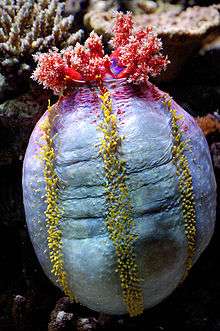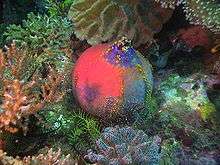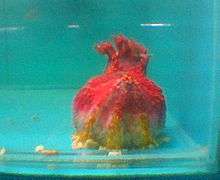Sea apple
| Sea apple | |
|---|---|
 | |
| Pseudocolochirus violaceus | |
| Scientific classification | |
| Kingdom: | Animalia |
| Phylum: | Echinodermata |
| Class: | Holothuroidea |
| Order: | Dendrochirotida |
| Family: | Cucumariidae |
| Genus: | Paracucumaria |
| Species[2] | |
| |
| Synonyms [2] | |
|
Koehleria Cherbonnier, 1988 | |
Sea apple is a common name for the colorful and somewhat round sea cucumbers of the genera Paracucumaria and Pseudocolochirus, found in Indo-Pacific waters.[3][4] Sea apples are filter feeders with tentacles, ovate bodies, and tube-like feet. They can release their internal organs or a toxin into the water when stressed.[4][5]
Physiology

Sea apples are holothuroids, and as such share many of the same physical characteristics. A few notable characteristics are discussed below. For more information about the physiology of holothuroids in general, see the appropriate sections in the main article Sea cucumbers.
Anatomy and feeding
The ovate body of an adult sea apple can grow up to 7.8 inches (20 cm) long.[6] A central mouth-like cavity is surrounded by feathery tentacles, which add additional length.[5] Sea apples, like many echinoderms, have rows of tube feet which help them move over and adhere to structures.[5]
The bodies and tentacles of sea apples come in many different colorings. The Australian species has a primarily purple body, red feet, and purple and white tentacles.[5]
The sea apple feeds primarily on plankton, which it filters from the water with its tentacles.[5] It alternately brings each tentacle to its mouth, scraping off the captured plankton.[4]
Sea apples usually feed at night at which time their delicate tentacles are less at risk from predators.[4]
Defense
When disturbed, sea apples, like other holothuroids, can projectile vomit their entrails from both ends.[7] In addition, sea apples can release a toxic saponin called holothurin into the water as a defense mechanism.[6]
In addition, if threatened or in an unsuitable environment, sea apples can consume large amounts of surrounding seawater to swell to nearly double their original size, this allows them to be moved to a new area by water currents, and much more quickly than they could walk.[8]
Problems in captivity
Because of their interesting appearance and behaviour, sea apples are often widely desired as specimen for display marine aquaria. They are considered reef safe as far as their compatibility with other species.[6] However, they can be considered unsafe for reef aquaria for multiple reasons:
Starvation
Sea apples often starve to death in display aquaria.[5] Levels of plankton in aquaria are often lower than optimal, and sea apples are often seen attempting to feed not only at night, as in their natural habitat, but also in the daytime.[4] With only low levels of food available, these sea apples often starve, becoming progressively smaller as this happens.[5] To try to circumvent these problems, hobbyists attempt to give the sea apple specimens supplemental feedings of plankton and liquid food.[4][8]
Harassment and predation
Sea apples are often harassed by many aquarium inhabitants. Crustaceans, such as hermit crabs, and fish often pick on sea apple's feathery tentacles.[5][8] This may be for predatory purposes, or simply to steal trapped particles and plankton from the tentacles.[8]
Occasionally, sea apples use their defense mechanisms in response to harassment. The release of their toxin can poison other aquarium inhabitants,[6][8] and is one of the reasons they are not commonly seen in aquariums.[9]
Captivity Guide
Although rare, sea apples are kept in captivity. They need special care as to avoid the release of toxins.
Feeding
It is recommended to feed 4-6 times a week, everyday if possible, with phytoplankton.
Tankmates
Many fish will avoid the sea apple, but some, like pufferfish and damsels might pick. Invertebrates also have learned to avoid it, but hermits and canel shrimp might bother it.
References
- ↑ WoRMS (2009). "Paracucumaria Panning, 1949". World Register of Marine Species. Retrieved October 29, 2016.
- 1 2 3 WoRMS (2009). "Pseudocolochirus Pearson, 1910". World Register of Marine Species. Retrieved March 8, 2010.
- ↑ "Sea apple sea cucumber (Pseudocolochirus violaceaus) on Chek Jawa, Pulau Ubin, Singapore." Wildsingapore homepage. 2003. <http://www.wildsingapore.com/chekjawa/text/c624.htm>.
- 1 2 3 4 5 6 Stratton, Richard. Mini Reef Aquariums Yearbook. Neptune, NJ: T. F. H. Publications. ISBN 0-7938-1976-8.
- 1 2 3 4 5 6 7 8 Haywood, Martyn; Sue Wells (1989). The Manual of Marine Invertebrates. Morris Plains, NJ: Tetra Press:Salamander Books Ltd. p. 208. ISBN 3-89356-033-5.
- 1 2 3 4 Nilsen, Alf Jacob; Svein A. Fosså (2002). Reef Secrets. Neptune City, NJ: T.F.H. Publications. ISBN 978-1-890087-67-8.
- ↑ Goldstein, Robert J. (1997). Marine Reef Aquarium Handbook. Hauppauge, NY: Barron's Educational Series, Incorporated. ISBN 0-8120-9598-7.
- 1 2 3 4 5 Lougher, Tristan (2007). What Invertebrates?: A Buyer’s Guide for Marine Aquariums. Hauppauge, NY: Barron's Educational Series, Incorporated. ISBN 978-0-7641-3741-9.
- ↑ "Saltwater Invertebrates for Marine Reef Aquariums: Sea Apple." Aquarium Fish: Tropical Freshwater Fish and Saltwater Fish for Home Aquariums. 2008. <http://www.liveaquaria.com/product/prod_display.cfm?c=497+502+711&pcatid=711>.
